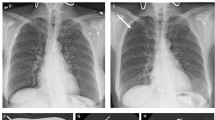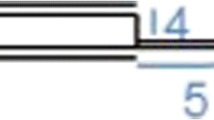Abstract
Purpose
The number of core biopsy passes required for adequate next-generation sequencing is impacted by needle cut, needle gauge, and the type of tissue involved. This study evaluates diagnostic adequacy of core needle lung biopsies based on number of passes and provides guidelines for other tissues based on simulated biopsies in ex vivo porcine organ tissues.
Methods
The rate of diagnostic adequacy for pathology and molecular testing from lung biopsy procedures was measured for eight operators pre-implementation (September 2012–October 2013) and post-implementation (December 2013–April 2014) of a standard protocol using 20-gauge side-cut needles for ten core biopsy passes at a single academic hospital. Biopsy pass volume was then estimated in ex vivo porcine muscle, liver, and kidney using side-cut devices at 16, 18, and 20 gauge and end-cut devices at 16 and 18 gauge to estimate minimum number of passes required for adequate molecular testing.
Results
Molecular diagnostic adequacy increased from 69% (pre-implementation period) to 92% (post-implementation period) (p < 0.001) for lung biopsies. In porcine models, both 16-gauge end-cut and side-cut devices require one pass to reach the validated volume threshold to ensure 99% adequacy for molecular characterization, while 18- and 20-gauge devices require 2–5 passes depending on needle cut and tissue type.
Conclusion
Use of 20-gauge side-cut core biopsy needles requires a significant number of passes to ensure diagnostic adequacy for molecular testing across all tissue types. To ensure diagnostic adequacy for molecular testing, 16- and 18-gauge needles require markedly fewer passes.



Similar content being viewed by others
References
Frampton GM, Fichtenholtz A, Otto GA, Wang K, Downing SR, He J, et al. Development and validation of a clinical cancer genomic profiling test based on massively parallel DNA sequencing. Nat Biotechnol. 2013;31:1023–31.
Lalji UC, Wildberger JE, Zur Hausen A, Bendek M, Dingemans A-MC, Hochstenbag M, et al. CT-Guided percutaneous transthoracic needle biopsies using 10G large-core needles: initial experience. Cardiovasc Intervent Radiol. 2015;38:1603–10.
Hiley CT, Le Quesne J, Santis G, Sharpe R, de Castro DG, Middleton G, et al. Challenges in molecular testing in non-small-cell lung cancer patients with advanced disease. Lancet. 2016;388:1002–11.
Corless CL. Next-generation sequencing in cancer diagnostics. J Mol Diagn. 2016;18:813–6.
Pritchard CC, Salipante SJ, Koehler K, Smith C, Scroggins S, Wood B, et al. Validation and implementation of targeted capture and sequencing for the detection of actionable mutation, copy number variation, and gene rearrangement in clinical cancer specimens. J Mol Diagn. 2014;16:56–67.
Austin MC, Bs CS, Pritchard CC, Tait JF. DNA yield from tissue samples in surgical pathology and minimum tissue requirements for molecular testing. Arch Pathol Lab Med. 2016;140:130–3.
Cho M, Ahn S, Hong M, Bang H, Van Vrancken M, Kim S, et al. Tissue recommendations for precision cancer therapy using next generation sequencing: a comprehensive single cancer center’s experiences. Oncotarget. 2017;8:42478–86.
Yang C-S, Choi E, Idrees MT, Chen S, Wu HH. Percutaneous biopsy of the renal mass: FNA or core needle biopsy? Cancer. 2017;125:407–15.
Patel K, Kinnear D, Quintanilla NM, Hicks J, Castro E, Curry C, et al. Optimal diagnostic yield achieved with on-site pathology evaluation of fine-needle aspiration–assisted core biopsies for pediatric osseous lesions: a single-center experience. Arch Pathol Lab Med. 2017;141:678–83.
Roy-Chowdhuri S, Chen H, Singh RR, Krishnamurthy S, Patel KP, Routbort MJ, et al. Concurrent fine needle aspirations and core needle biopsies: a comparative study of substrates for next-generation sequencing in solid organ malignancies. Mod Pathol. 2017;30:499–508.
Roy-Chowdhuri S, Goswami RS, Chen H, Patel KP, Routbort MJ, Singh RR, et al. Factors affecting the success of next-generation sequencing in cytology specimens. Cancer Cytopathol. 2015;123:659–68.
Schneider F, Smith MA, Lane MC, Pantanowitz L, Dacic S, Ohori NP. Adequacy of core needle biopsy specimens and fine-needle aspirates for molecular testing of lung adenocarcinomas. Am J Clin Pathol. 2015;143:193–200 (quiz 306).
Tam AL, Lim HJ, Wistuba II, Tamrazi A, Kuo MD, Ziv E, et al. Image-guided biopsy in the era of personalized cancer care: proceedings from the society of interventional radiology research consensus panel. J Vasc Interv Radiol. 2016;27(1):8–19.
Moore HM, Compton CC, Lim MD, Vaught J, Christiansen KN, Alper J. 2009 Biospecimen research network symposium: advancing cancer research through biospecimen science. Cancer Res. 2009;69:6770–2.
Gupta S, Wallace MJ, Cardella JF, Kundu S, Miller DL, Rose SC, et al. Quality improvement guidelines for percutaneous needle biopsy. J Vasc Interv Radiol. 2010;21:969–75.
Focke CM, Decker T, van Diest PJ. The reliability of histological grade in breast cancer core needle biopsies depends on biopsy size: a comparative study with subsequent surgical excisions. Histopathology. 2016;69:1047–54.
Häggarth L, Ekman P, Egevad L. A new core-biopsy instrument with an end-cut technique provides prostate biopsies with increased tissue yield. BJU Int. 2002;90:51–5.
Veltri A, Bargellini I, Giorgi L, Almeida PAMS, Akhan O. CIRSE guidelines on percutaneous needle biopsy (PNB). Cardiovasc Interv Radiol. 2017. https://doi.org/10.1007/s00270-017-1658-5.
Geraghty PR, Kee ST, McFarlane G, Razavi MK, Sze DY, Dake MD. CT-guided transthoracic needle aspiration biopsy of pulmonary nodules: needle size and pneumothorax rate. Radiology. 2003;229:475–81.
Abe H, Schmidt RA, Sennett CA, Shimauchi A, Newstead GM. US-guided core needle biopsy of axillary lymph nodes in patients with breast cancer: why and how to do it. Radiographics. 2007;27(Suppl 1):S91–9.
Ward SR, Lieber RL. Density and hydration of fresh and fixed human skeletal muscle. J Biomech. 2005;38:2317–20.
RStudio Team. RStudio: integrated development for R [Internet]. Boston: RStudio, Inc. (2015). http://www.rstudio.com/.
Kobara H, Mori H, Rafiq K, Fujihara S, Nishiyama N, Chiyo T, et al. Analysis of the amount of tissue sample necessary for mitotic count and Ki-67 index in gastrointestinal stromal tumor sampling. Oncol Rep. 2015;33:215–22.
Solomon SB, Zakowski MF, Pao W, Thornton RH, Ladanyi M, Kris MG, et al. Core needle lung biopsy specimens: adequacy for EGFR and KRAS mutational analysis. AJR Am J Roentgenol. 2010;194:266–9.
Tam AL, Kim ES, Lee JJ, Ensor JE, Hicks ME, Tang X, et al. Feasibility of image-guided transthoracic core-needle biopsy in the BATTLE lung trial. J Thorac Oncol. 2013;8:436–42.
Pirker R, Herth FJF, Kerr KM, Filipits M, Taron M, Gandara D, et al. Consensus for EGFR mutation testing in non-small cell lung cancer: results from a European workshop. J Thorac Oncol. 2010;5:1706–13.
Dacic S. Molecular diagnostics of lung carcinomas. Arch Pathol Lab Med. 2011;135:622–9.
Dogan HS, Eskicorapci SY, Ertoy-Baydar D, Akdogan B, Gunay LM, Ozen H. Can we obtain better specimens with an end-cutting prostatic biopsy device? Eur Urol. 2005;47(3):297–301.
Ubhayakar GN, Li WY, Corbishley CM, Patel U. Improving glandular coverage during prostate biopsy using a long-core needle: technical performance of an end-cutting needle. BJU Int. 2002;89:40–3.
Wang J, Wan B, Li C, Wang J, Fu Q, Zhao W, et al. Diagnostic yield and complications using a 20 gauge prostate biopsy needle versus a standard 18 gauge needle: a randomized controlled study. Urol J. 2015;12:2329–33.
Author information
Authors and Affiliations
Corresponding author
Ethics declarations
Conflict of interest
All authors declare that they have no conflicts of interest.
Ethical Approval
All applicable institutional and/or national guidelines for the care and use of animals were followed.
Rights and permissions
About this article
Cite this article
Hoang, N.S., Ge, B.H., Pan, L.Y. et al. Determining the Optimal Number of Core Needle Biopsy Passes for Molecular Diagnostics. Cardiovasc Intervent Radiol 41, 489–495 (2018). https://doi.org/10.1007/s00270-017-1861-4
Received:
Accepted:
Published:
Issue Date:
DOI: https://doi.org/10.1007/s00270-017-1861-4




